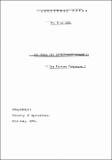| dc.description.abstract | This study analysed households’ use of formal and informal finance, non-finance livelihood
diversification and the social safety net measures in coping with droughts and floods. It
employed a cross-sectional survey of 1370 households across 27 counties in Kenya that are
prone to droughts and floods. Bivariate probit regressions reveal that households employ
multiple coping measures related to finance, the social safety net and non-finance choices.
The use of coping measures vary by household income, household dependency ratio, geographic
and agro-climatic contexts, as well as the household head’s age and educational
attainment. Further, the findings reveal that the use of the social safety net and non-finance
coping mechanisms demonstrate complementarities in coping with droughts, suggesting
that opportunities to benefit from the social safety net do not dampen livelihood diversification
initiatives by the households. Additionally, households in arid and semi-arid lands
(ASALs) depend to a large extent on the social safety net and non-finance livelihood diversification
coping mechanisms, signalling the need to explore ways that encourage private
sector development in promoting market-oriented coping strategies. | en |




